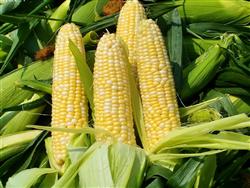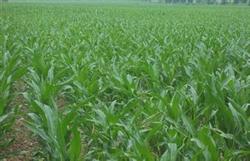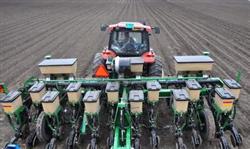Key points of cultivation techniques of Special Maize

Special corn includes forage corn, waxy corn, sweet corn and popcorn. The botanical and biological characteristics of special maize are different from those of ordinary corn, so it also has its special requirements in cultivation techniques. Forage corn is a variety of corn used for silage or silage. At present, the varieties that can be used as forage corn in our province are Ludan 50, LD963, Ludan 981, Yedan 22 and so on. The key point of cultivation management is: ① sowing by stages. For direct green feeding cultivation, in order to prolong the supply time of green fodder, the seeds can be sowed in stages with an interval of 15 mi 20 days. ② increased the density. The planting density of forage corn is generally 3 or more higher than that of grain corn, about 7000 plants per 15 ha. ③ has plenty of fertilizer and water. Due to the high planting density of forage corn and high requirements for fertilizer and water, it is necessary to properly increase the application of nitrogen, phosphorus and potassium fertilizer, especially potassium fertilizer, and timely watering in order to obtain higher forage yield. ④ is suitable for harvest. The best harvest time of silage corn is generally more than 40 days after pollination, that is, the early wax ripening stage of grain growth and development, the stage of milk line 4 (the milk line on the grain drops to 3 inch 4 of the grain). Second, the fresh and tender ears of waxy corn can be used for green food and vegetables, and glutinous jade rice flour can also be used to make rice cakes and snacks. Waxy corn varieties include Lunuo 2, Lunuo 5 and Lunuo 6, which were bred by Maize Research Institute of Shandong Academy of Agricultural Sciences. The main requirements in corn production are: ① isolation planting. The viscosity of waxy corn and common corn decreased after mixing flour, and some unique characters were lost. So when planting, it should be isolated from ordinary corn. There are three methods of isolation: spatial isolation, time isolation and barrier isolation. The distance of spatial isolation is generally 300MUR 400 meters. Time isolation requires more than 40 days between spring sowing and 25 days between summer sowing. Barrier isolation can be used to plant tall crops such as sorghum and kenaf around waxy corn fields to achieve the purpose of isolation. ② sowed seeds in stages. If there is no cold storage condition and the purpose of cultivation is to cook fresh ears, spring sowing, summer sowing or multi-stage sowing can be carried out in order to supply the market continuously. it can also be cultivated with plastic film in late March and early April. ③ controls pests. After corn ears are damaged by beetles, corn borer and cotton bollworm, the commodity quality of corn ears decreases and should be controlled in time. ④ harvested at the right time. Those who cook fresh ears are generally harvested in the 30th day after pollination, while those who grind grains should be harvested when the corn is fully ripe. There are three kinds of sweet corn: ordinary sweet, super sweet and added sweet. Sweet corn can be eaten raw or cooked, and can be made into canned products. Sweet corn varieties include Tianyu 2, Tianyu 4 and Tianyu 6 selected by Chinese Academy of Agricultural Sciences, Ketian 110 jointly developed by Institute of Genetics of Chinese Academy of Sciences and Zhongnong improved Variety Company, Tianyu 1 bred by Shandong Agricultural University and Taian seed Company, and so on. The main requirements of cultivation are: ① isolated planting. After receiving the pollen of ordinary corn, the phenomenon of direct sensation of pollen will occur in sweet corn, which will greatly reduce the quality of sweet corn. Therefore, sweet corn should be planted in isolation from other corn to prevent flour bunching. ② fine sowing. Sweet corn seeds due to low starch content, so the grain is thin, lack of nutrition, poor top soil capacity, it is not easy to take the whole seedling, even if the seedling, it is difficult to achieve strong seedlings. Therefore, the seeds should be carefully selected and the soil should be prepared carefully before sowing. Sowing depth, super sweet corn should not exceed 3 cm, general sweet corn should not exceed 4 cm. For the sweet corn planted for the purpose of cooking fresh and tender ears, plastic film mulching can be used in order to go on the market earlier. ③ controls insect pests. Sweet corn plant is sweeter than ordinary corn, and the insect pest is serious, especially after corn ear is bitten by corn borer and beetle, the commodity quality decreases. Therefore, pest control is particularly important for sweet corn. ④ harvested in good time. The suitable harvest time of sweet corn is about 20 days after pollination. Popcorn processed with popcorn is a kind of nutritious health and leisure food. Popcorn varieties include Yellow Rose and Yellow Rose No. 2 bred by Chinese Academy of Agricultural Sciences and Tai Pao No. 1 bred by Shandong Agricultural University. The production of this kind of corn mainly emphasizes three links: first, because the seed of popcorn is small and emerges slowly, it needs fine sowing; second, most popcorn varieties have the characteristic of outcrossing sterility, that is, filaments can only accept pollen of their own or the same variety and are fertilized and fruited, and after pollens of other types of corn are given, it is not necessary to isolate them. Third, it is harvested at the full maturity stage, because the popcorn with the maximum popcorn coefficient can be processed only after the grain of popcorn is fully mature.
- Prev

How to ensure "one sowing whole Seedling" in sowing Summer Maize
If summer corn wants to realize "one sowing whole seedling", in addition to selecting excellent seeds, we should also pay attention to the following aspects: sowing should not be too deep: the most suitable sowing depth of summer corn is 3mi 5cm. If the sowing is too deep, the low temperature is easy to rett, even if it can barely emerge, the seeds will be buried too deep.
- Next

Key points of interplanting maize sowing technology
To improve the quality of sowing in order to ensure that corn seedlings complete, seedlings strong, general mu application of 5 kg of diammonium phosphate and 1 kg of zinc sulfate as seed fertilizer, before sowing the piles of wheat straw evenly dispersed, so as not to affect the seeding emergence, sowing attention to the operating speed of the seeder, in case of missed sowing or sowing seeds on wheat stubble, to try to do "row...
Related
- The first cup of black tea in spring, the flavor and history of tea gardens in Kenya, Africa
- The computer can not only choose potatoes, but also grow tea rice. AI will grow winter oolong tea champion.
- It is not only the inflated tea bitten by insects, but also engraved with the four seasons tea in Beipu.
- The Oriental Beauty Tea Festival in Zhuxian County takes the stage at the weekend to experience the plus-size feast of oil tea.
- & quot; Oriental Beauty Tea & Exploration of Emei in Hsinchu, the hometown of quot;
- The new variety of strawberry "Tainong 1" dessert is the first choice with mellow aroma. Crimson gorgeous
- History of Tea in Taiwan: from Wild Inner Mountain to Export Tea Garden
- Two types of Taiwan Oriental Beauty Black Tea won the British three-Star Award for Childhood Tea Xiang Zhang Jiaqi changed from pilot to champion tea maker.
- Banana species and varieties: the planting history of Taiwan Xianren banana and dwarf banana is long, is banana disease resistant?
- Coffee planting Technology: Qianjie Coffee from Seedling to harvesting

